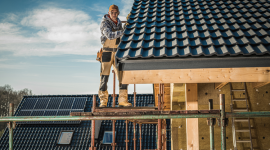When heavy rains hit, a commercial roof can quickly turn from protection to problem. Roof drainage might not be the first thing building owners think about, but it plays a huge part in keeping everything underneath safe and dry. If water can’t make its way off the roof fast enough, it can start pooling, leaking, or even damaging the building structure. That’s why having the right drainage setup is important for any commercial property.
In Albuquerque, monsoon season can sneak up fast. It brings quick-moving storms, sudden downpours, and a lot of water in a short amount of time. Without proper drainage, that rain sticks around, weighing down the roof and creeping into places it shouldn’t be. Getting ahead of the storm means understanding how that water moves and making sure it’s directed away from the building as efficiently as possible.
Understanding Monsoon Season in Albuquerque
Monsoon season in Albuquerque usually kicks off mid-summer and stretches into early fall. In those months, storms often form in the afternoons and dump large amounts of rain in just a few minutes. The dry desert ground doesn’t absorb water quickly and neither do flat commercial roofs. That combination makes clogs, overflows, and drainage failures more likely.
Flat or low-slope commercial roofs are especially prone to water issues mostly because there’s less natural runoff. Instead of flowing downhill, the rain needs a designed path to exit, and if anything blocks that path, water collects fast. Unlike homes with pitched roofs, commercial properties depend more on built-in systems like scuppers, internal drains, and downspouts to manage the downpour.
Stormwater can also bring loads of debris. Winds push leaves, dirt, and litter around and dump it onto rooftops. That stuff clogs up drains and gutters in no time. If downspouts are narrow or poorly placed, they can’t handle the surge. One Albuquerque business owner we worked with had piles of wet leaves clogging their scuppers after just one storm. The result? Downpour runoff backed up onto the roof and started leaking into ceiling tiles by morning.
Understanding the storm patterns and how roofs behave during the season can make planning much easier. And once you know how water flows and where it tends to stick around, you can spot the weak points quicker.
Key Elements of Effective Roof Drainage Systems
A commercial roof doesn’t just need drains. It needs the right combination of parts all working together to move water off quickly. Effective drainage isn’t about size alone. It’s about access, flow, and regular upkeep. Here are some key elements that help roofs stay dry, even in the thick of monsoon season.
1. Clean, clear gutters
Gutters guide water toward drains or downspouts. But when they fill up with debris or sediment, water builds up and spills over instead of flowing out. Keeping them clean goes a long way.
2. Downspouts and extensions
Downspouts channel water down and away from the roof and foundation. If they’re too narrow, angled poorly, or missing extensions, water can end up pooling near the base of the building or backing up onto the roof.
3. Proper slope and layout
Even on low-slope roofs, there should be just enough angle to help water find its way to a drain. Flat spots or uneven areas create puddles that stick around long after the rain stops.
4. Scuppers and parapet drainage
On roofs with raised edges, wall scuppers are common. These openings help push water out through the walls. They need to stay clean and free of blockages to work well.
5. Overflow systems
When the main drains can’t keep up, overflow drains give the extra water somewhere to go. These are a backup, but in monsoon conditions, they become just as important as the primary routes.
All of these components need to be kept in working condition, especially before storm season starts. Designs count, but upkeep often makes the biggest difference. A perfectly sloped roof won’t help if the drains are jammed. Taking the time to understand these pieces helps prevent more costly problems later.
Preventive Measures and Regular Maintenance
Regular checks and seasonal prep work can make a big difference during Albuquerque’s monsoon season. Waiting until storms are overhead is usually too late to catch problems before they grow. Setting up a good maintenance routine for your commercial property helps catch potential issues while they’re still easy to fix.
Start with inspections a few weeks before monsoon begins. Walk the roof, check for standing water, and look at all the drains, scuppers, and downspouts. Make sure nothing’s blocked or cracked. Remove any leaves, branches, or leftover construction debris. Something as simple as a soda bottle stuck in a drain can cause major flooding under heavy rain.
Once monsoon season is underway, don’t assume everything’s fine. After big storms, do a quick visual check from the ground, especially around the edges of the roof. Watch for overflow in areas you’re not used to seeing water. Damp spots on ceilings or bubbling paint indoors usually mean there’s water collecting above.
Here are some warning signs that could point to drainage issues:
– Water pooling on the roof more than 48 hours after rain
– Stains or discoloration along interior ceilings and walls
– Moldy smells inside the building
– Water flowing down exterior walls where it shouldn’t
– Sagging areas on the roof surface
Spotting these early lets you deal with them before they become larger problems. If your property has tenants or stays open during storms, keep an ear out for reports of drips, leaks, or damp smells inside. Those details can help narrow down exactly where drainage might be failing.
Professional Support for Roof Drainage Solutions
Even with regular upkeep, it’s easy to miss things unless you’re specifically trained in how commercial roof drainage systems work. That’s where experienced roofing professionals come in. They know how to read slopes, spot weak areas, and test systems before problems show up in the middle of a storm.
When you hire a professional, they’re looking at your entire drainage system, not just one or two parts. They’ll check that all components from gutters to downspouts to internal roof drains are connected and capable of handling water flow during monsoon storms. They’ll also identify improper slopes that might be encouraging pooling, and they can assess whether current hardware is up to the job or if upgrades are needed.
Working with an expert also means they’ll keep records of past inspections. Over time, this helps spot patterns, especially if the same parts of the roof keep running into trouble year after year.
Example: One local property owner had a large flat roof with consistent water pooling right next to a rooftop HVAC unit. A professional crew discovered that a blocked internal drain pipe beneath that section of roofing was diverting water to all the wrong places. Without getting that specific pipe cleared and re-routed, other repairs wouldn’t have helped. That’s the kind of detail a trained team can spot and fix quickly.
Fixing major issues during the middle of monsoon season becomes more expensive and disruptive. It usually means halting operations, moving tenants, or dealing with interior water damage. Getting ahead of the rain with expert help costs much less in the long run.
Staying Dry and Protected During Albuquerque’s Monsoon Season
Commercial roof drainage shouldn’t be an afterthought. When storms move in fast, there’s no time to troubleshoot or guess where the water’s going. By getting the right systems in place ahead of time and maintaining them during the season, you can reduce stress and avoid expensive surprises.
Albuquerque’s monsoon weather doesn’t hold back, but neither should your preparation. Every roof is different, and what works for one building won’t always apply to another. That’s why it’s smart to take a detailed approach backed by experience. Planning, checking, and partnering with the right people can go a long way toward keeping your commercial property high and dry.
Monsoon season moves fast, and your building’s roof should be ready before the rain hits. Sol System Builders is here to help with expert service and long-term solutions for managing roofing for commercial properties. Reach out today to keep your drainage system working right and your property protected.





